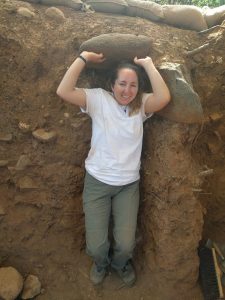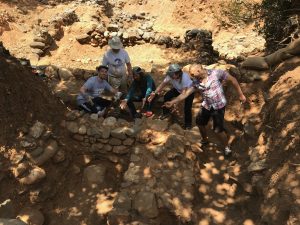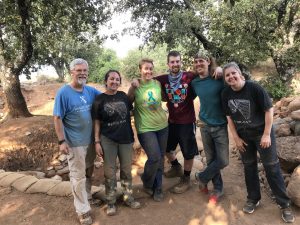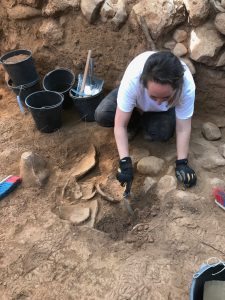
THE ARCHAEOLOGY OF ARCHAEOLOGY
Amanda Bauer, 2018 Shirlee Meyers Excavation Fellowship Recipient
To begin, I would like to thank Eric and Carol Meyers for awarding me the 2018 Shirlee Meyers Excavation Fellowship. With their support, I had the great opportunity to excavate at Tel Dan for the
2018 dig season. I also give thanks to Professors Aaron Burke and David Ilan for being so patient with me as a first time staff member – your guidance and support this season was invaluable and immensely inspiring. Lastly, a huge thank you to all the volunteers I had the pleasure of working with this season; without you all, we would not have accomplished what we did. Thank you for your persistence, inquisitive minds, and allowing me to learn beside you.
The 2018 Excavation Season
From June 18 to July 12, UCLA joined Hebrew Union College (directed by Prof. David Ilan) to excavate at Tel Dan, as per the Turning Points Project beginning this year. Tel Dan is an archaeological site in northern Israel, most famous for the stele found referencing the House of David, דוד בית. This season, UCLA supervised excavations in Area B – a domestic context previously excavated by Prof. Avraham Biran. Our main research objective was to better date the transition from Late Bronze Age to early Iron Age (phases IVB, V, and VI). We are currently waiting for results from faunal and botanical remains.
This season I had the role of square supervisor . As my previous experience in the field was as a volunteer, I have a new appreciation for the amount of paperwork and data sorting it takes to prepare for each season and publication – I never imagined I’d be excavating through files from previous seasons in order to physically excavate in the field (a whole new meaning of archaeology). And just as every archaeologist has their own field methods and habits, so do they in their database and organizational structures. The outcome of an excavation has just as much to do with the methodology and analysis as it does with the material culture presented. My participation as a square supervisor at Tel Dan this summer thus gave me great insight into how many seasons it can take to find that one locus you’ve been searching for (not in 2016, or in 2014, but maybe in 2012 .…)
A second unmentioned aspect of supervising is that of people management. Not only am I required to excavate previous seasons’ data, as well as excavate current material in the field, but also guide the volunteers with whom I am working. Archaeology may be a social science studying material remains from antiquity, but we must also work with humans still holding onto their soft tissue (excluding the bog people, in this case) in order to achieve this. Therefore, an instructive supervisor must also have communication skills – this is not taught while researching burial practices for a senior thesis, unfortunately.
My last major takeaway from this summer is that the season is not over when the volunteers leave the site. When the physical labor ceases, is when the mental labor begins – the files have been
excavated, the site has been further excavated, and now my field journal and memory will be excavated to complete the final report of the season. At this point of the season, I found solace in knowing I was not the only supervisor frantically looking through their notes to figure out what that one stone was doing in that one locus… I could feel Van Gennep’s Rites de Passage as I slowly began the transition into the life of an archaeologist, and I could not be more ecstatic.
Amanda Bauer graduated summa cum laude from the University of Arizona in 2017 with a dual-major in Anthropology and Judaic Studies. She is beginning her PhD at the University of California, Los Angeles in the Department of Near Eastern Languages & Cultures this fall 2018. Amanda’s main interests include Levantine Archaeology, Late Bronze and early Iron Age, Hebrew Bible and cultural formation and identity.




